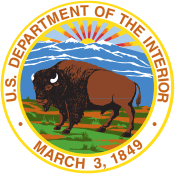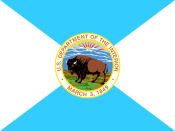United States Department of the Interior facts for kids

Seal of the U.S. Department of the Interior
|
|

Flag of the U.S. Department of the Interior
|
|
 Exterior of the main Interior Building |
|
| Agency overview | |
|---|---|
| Formed | March 3, 1849 |
| Type | Department |
| Jurisdiction | Federal Government of the United States |
| Headquarters |
38°53′40″N 77°02′33″W / 38.89444°N 77.04250°W |
| Employees | 67,026 |
| Annual budget | $17.6 billion (2022) |
| Agency executives |
|
The United States Department of the Interior (DOI) is a part of the U.S. federal government. It is in charge of managing and protecting most of the country's federal lands and natural resources. This includes national parks, wildlife refuges, and other public areas.
The DOI also runs programs for Native Americans, Alaska Natives, and Native Hawaiians. It helps with affairs in U.S. territories and works to preserve important historical sites. About 75% of all federal public land is managed by this department. The department started on March 3, 1849. Its main office is in Washington, D.C..
The leader of the department is the Secretary of the Interior. This person reports directly to the president of the United States and is a member of the president's Cabinet. The current Secretary is Doug Burgum.
As of 2004, the department managed over 500 million acres of land. This is about one-fifth of all the land in the United States. It also oversees many dams and reservoirs through the Bureau of Reclamation. The National Park Service manages national parks and historical sites. The Fish and Wildlife Service looks after national wildlife refuges. The Bureau of Land Management is the largest land agency, managing a huge amount of land.
Even though it's called the "Department of the Interior," its job is different from similar departments in other countries. In many places, "interior ministries" handle police and security. In the U.S., these jobs are done by the Department of Homeland Security and the Department of Justice. Because the DOI handles so many different things, people sometimes jokingly call it "the Department of Everything Else."
Contents
History of the Department
How the Department Started
The idea for a department focused on domestic issues came up way back in 1789. At first, these duties were given to the Department of State. But the idea of a separate department kept coming up for about 50 years. Presidents like James Madison and James Polk supported it.
After the Mexican–American War (1846–1848), the U.S. government had more responsibilities. This made the idea of a new department even more popular. Robert J. Walker, who was the Secretary of the Treasury, strongly pushed for its creation.
In 1849, Walker explained that many government offices were in departments that didn't really fit. For example, the United States General Land Office was with the Treasury. The Indian Affairs office was with the Department of War. The Patent Office was with the State Department. Walker argued that these offices should be together in a new Department of the Interior.
The bill to create the department passed the House of Representatives in February 1849. It then went to the Senate. The department was officially created on March 3, 1849. This was just before President Zachary Taylor became president. Some members of Congress tried to delay it. They didn't want the new president's party to get too many new jobs. The first Secretary of the Interior was Thomas Ewing.
Changes Over Time
Over the years, some of the original jobs of the Department of the Interior moved to other departments. For example, it used to handle water pollution control. Now, the Environmental Protection Agency does that. Some agencies, like the Bureau of Agriculture, even became their own departments. The Bureau of Agriculture later became the Department of Agriculture.
However, the Department of the Interior still manages land and natural resources. It also continues to handle American Indian affairs, wildlife conservation, and matters related to U.S. territories.
Supporting American Indian Communities
Within the Department of the Interior, the Bureau of Indian Affairs (BIA) works with American Indian nations. The Office of Special Trustee also helps with some federal relations. Bryan Newland, a member of the Bay Mills Indian Community, is currently the acting assistant secretary for Indian affairs.
The department helps manage special funds for American Indian communities. These funds come from leasing tribal lands for things like oil, timber, and minerals. Sometimes, there have been disagreements about how these funds were managed. In 2010, Congress passed a law called the Claims Settlement Act. This law provided money to resolve some of these long-standing issues. It also helped settle cases about water rights for American Indian nations.
On March 16, 2021, Deb Haaland became the Secretary of the Interior. She was the first American Indian person to lead a major U.S. government department. She was also the third woman to lead the department.
How the Department Works
The Department of the Interior has many different offices and agencies. Each one focuses on a specific part of the department's mission. Here are some of the main groups:
- Assistant Secretary for Policy, Management, and Budget: This group helps manage the department's policies, money, and overall operations. It includes offices for environmental policy, international affairs, and human resources. It also oversees the National Invasive Species Council.
- Assistant Secretary for Fish and Wildlife and Parks: This office oversees the National Park Service and the United States Fish and Wildlife Service. These agencies protect national parks, monuments, and wildlife.
- Assistant Secretary for Indian Affairs: This office works with the Bureau of Indian Affairs (BIA) and the Bureau of Indian Education (BIE). They help manage federal relations with American Indian nations and support education.
- Assistant Secretary for Land and Minerals Management: This group includes the Bureau of Land Management, which manages vast public lands. It also oversees the Office of Surface Mining Reclamation and Enforcement and agencies related to ocean energy.
- Assistant Secretary for Water and Science: This office works with the United States Geological Survey, which studies the Earth. It also oversees the Bureau of Reclamation, which manages water resources like dams and reservoirs.
- Assistant Secretary for Insular and International Affairs: This group handles matters for U.S. territories and islands. It also works on international environmental issues.
- Solicitor: This is the main legal office for the department.
- Office of the Inspector General (OIG): This office checks to make sure the department is working correctly and honestly.
- Special Trustee for American Indians: This office helps manage the trust funds for American Indian communities.
- Interior Museum: This museum tells the story of the department's history and work.
- National Indian Gaming Commission (NIGC): This commission regulates gaming activities on tribal lands.
Awards and Recognition
The DOI Convocation Honor Award is the highest award given by the Department of the Interior. Other important awards include:
- Safety and Health Award of Excellence & Aviation Safety Award
- Distinguished Service Award
- Citizen's Award for Bravery
- Valor Award
Regions of Operation
In 2018, the Department of the Interior created 12 new regions. These regions help organize the department's work across the country. They replaced many smaller regions that different agencies used to have.
Images for kids
-
The hierarchy of the U.S. Department of the Interior
-
Eastern entry station to Yosemite National Park
-
A Bureau of Indian Affairs firefighter at the La Jolla Indian Reservation
-
A Bureau of Land Management Wilderness Study Area in northern Alaska
See also
 In Spanish: Departamento del Interior de los Estados Unidos para niños
In Spanish: Departamento del Interior de los Estados Unidos para niños
- America's Great Outdoors Initiative
- Environmental policy of the United States
- USA.gov










